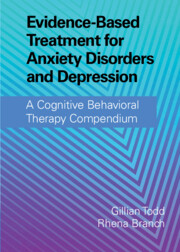 Evidence-Based Treatment for Anxiety Disorders and Depression
Evidence-Based Treatment for Anxiety Disorders and Depression from Part Six - Specialist Applications of Cognitive Behavioral Therapy for Anxiety Disorders and Depression
Published online by Cambridge University Press: 06 January 2022
Anxiety and depression impact many children and adolescents and cause significant impairments in multiple domains. Child and adolescent psychotherapy have now been researched for approximately 50 years and the extant literature suggests that structured, manualized treatments produce a significant benefit for this specific population. Overall, research indicates that youth-focused behavioral psychotherapies, including cognitive behavioral therapy (CBT), demonstrate robust effects across multi-informants (i.e., child/adolescent, parent, and teacher). Individual CBT for child and adolescent anxiety disorders and depression has a strong evidence base. When adapting and implementing CBT with young clients, there are important considerations regarding treatment planning, including assessment, diagnostic and differential considerations, case conceptualization, implementation of interventions, and consistent reassessment with outcome measures.
To save this book to your Kindle, first ensure [email protected] is added to your Approved Personal Document E-mail List under your Personal Document Settings on the Manage Your Content and Devices page of your Amazon account. Then enter the ‘name’ part of your Kindle email address below. Find out more about saving to your Kindle.
Note you can select to save to either the @free.kindle.com or @kindle.com variations. ‘@free.kindle.com’ emails are free but can only be saved to your device when it is connected to wi-fi. ‘@kindle.com’ emails can be delivered even when you are not connected to wi-fi, but note that service fees apply.
Find out more about the Kindle Personal Document Service.
To save content items to your account, please confirm that you agree to abide by our usage policies. If this is the first time you use this feature, you will be asked to authorise Cambridge Core to connect with your account. Find out more about saving content to Dropbox.
To save content items to your account, please confirm that you agree to abide by our usage policies. If this is the first time you use this feature, you will be asked to authorise Cambridge Core to connect with your account. Find out more about saving content to Google Drive.